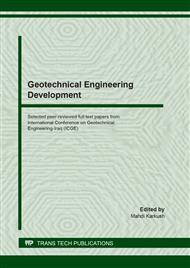p.145
p.153
p.162
p.169
p.179
p.188
p.195
p.203
p.212
A Field Study on Bearing Capacity of Al-Najaf Sandy Gypseous Soil
Abstract:
Gypseous considered as problematic soils also gypseous soils are distributed all over the world, as well as in large areas of Iraq, including Al- Najaf city. Gypseous soils are characterized by high strength in dry conditions, but they collapse due to water infiltration process under constant head conditions. In this research, a field study investigates gypseous soils and the effect of soaked state on the bearing capacity and settlement of the gypseous soils are investigated. A site with a high percentage of gypsum (about 25%) was selected to perform plate load tests. The test was carried out in a natural and soaked state on the gypseous soils by plate load test with time-dependent. The results show the ultimate bearing capacity of gypseous soil from plate load test are decrease under the soaking condition and maximum settlement increase. The angle of internal friction (ø) of gypseous soil we obtained from the direct shear test is 47.620 for natural soil. The ultimate bearing capacity of gypseous soil was calculated from the Terzaqhi’s equation and the high difference between field tests and theoretical results.
Info:
Periodical:
Pages:
179-187
Citation:
Online since:
August 2020
Authors:
Price:
Сopyright:
© 2020 Trans Tech Publications Ltd. All Rights Reserved
Share:
Citation:


